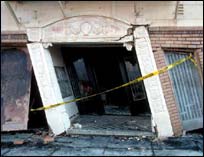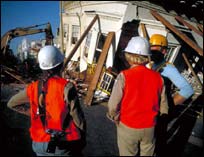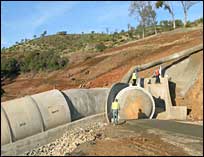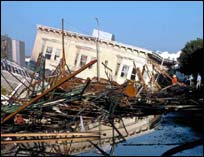|
Researchers believe there is a 62 percent chance another earthquake
rivaling the "great one" in 1906 will hit the San Francisco
Bay Area within the next 30 years.
Judging from the timing of past earthquakes in the region, two
of the main fault lines -- the Hayward and San Andreas faults
-- are due for a major quake of a magnitude 6.7 or higher, according
to a working group of U.S. Geological Survey scientists, universities
and private institutions.
"We're sitting on a tectonic time bomb," said USGS
research geologist David Schwartz. Efforts are under way to prepare
the bay area, such as rebuilding and strengthening bridges, water
systems and buildings, but the question is whether the area has
enough time, he explained.
 The
San Francisco Bay Area is vulnerable because it is built partly
on rock and partly on sand dunes. If a major earthquake hits,
the sandy areas would act as a liquid, causing unreinforced buildings
to topple. Many of the old brick and concrete structures, built
pre-1970s construction codes, would not survive. The
San Francisco Bay Area is vulnerable because it is built partly
on rock and partly on sand dunes. If a major earthquake hits,
the sandy areas would act as a liquid, causing unreinforced buildings
to topple. Many of the old brick and concrete structures, built
pre-1970s construction codes, would not survive.
Particularly vulnerable are apartment buildings -- built pre-1970s
when stricter buildings codes were put in place -- situated atop
parking garages and retail stores, which are considered "soft"
first stories because of their spindly support columns and basically
empty space.
Underground water pipelines that cross fault lines also could
bend or break, cutting off water supplies and making it difficult
to fight fires. Splintered and leaking gas pipelines could ignite
flash fires.
Localities have developed emergency plans to deal with the aftermath
of a destructive quake, but some problems remain. For instance,
San Francisco's pricey real estate prevents many fire and other
emergency personnel from living in the city, as became apparent
during the 1989 earthquake.
About one-third of the San Francisco Fire Department's 1,800
paid firefighters live in San Francisco, although a "high
majority" live within the nine bay area counties, said the
department's Chief Joanne Hayes-White.
 "It's
something I have some concerns about," Hayes-White said,
adding that she plans to address the issue in future contract
talks. "It's
something I have some concerns about," Hayes-White said,
adding that she plans to address the issue in future contract
talks.
Still, in an exercise conducted in October 2005 aimed at getting
emergency workers into the city, the bulk of personnel were able
to respond, she said.
Firefighters and police officers also have begun training together
in non-emergency settings so they will be better able to join
forces in the event of an actual emergency, she added.
Another issue the San Francisco Fire Department had to address
was its unique fire hydrants. If firefighters from other municipalities
ever had to assist with post-earthquake fires, their hoses wouldn't
be able to attach to the hydrants without special adaptors.
Many of San Francisco's fire stations now have adaptors to distribute
if needed, and caches of adaptors are located at four entry points
into the city, said Hayes-White.
The San Francisco Fire Department has never had to request assistance
since it came into existence in 1867, she said, although "it
would be burying my head in the sand to say we'd never need mutual
aid."
Water supplies and bay bridge reconstruction
San Francisco's Hetch Hetchy water system, which supplies 2.4
million residents with drinking water, crosses three fault lines:
the San Andreas, Hayward and Calaveras. The city has undertaken
a $4.3 billion, 10-year effort to upgrade the aging system to
make it more resistant to earthquakes, said Anthony Irons, deputy
general manager of the San Francisco Public Utilities Commission.
The plan entails repairing, replacing and strengthening the system's
pipelines, reservoirs, tunnels and dams, and creating redundancy
in case the pipelines burst.
 Currently,
if a major pipeline breaks, it might take 60 days to repair. The
goal of the redesign is to get at least some water to residents
in 24 hours and be able to restore water to full supply in 30
days, said Irons. Currently,
if a major pipeline breaks, it might take 60 days to repair. The
goal of the redesign is to get at least some water to residents
in 24 hours and be able to restore water to full supply in 30
days, said Irons.
The need to maintain a reliable water source for residents after
disaster strikes was never as clearly illustrated as after Hurricane
Katrina. When Katrina hit the Gulf Coast in August 2005, it stranded
thousands of New Orleans residents without drinking water.
"Water is a principle issue following disasters, as Katrina
showed," Irons said.
Another major reconstruction effort involves the double-decker
San Francisco-Oakland Bay Bridge, part of which collapsed during
the 1989 Loma Prieta earthquake.
The city and state decided to replace the 2.2 mile-long eastern
span with separate support systems for the upper and lower decks
at a cost of about $6.3 billion, according to Bart Ney, California
Department of Transportation spokesman on the bay bridge retrofit
project. Construction is expected to be completed in 2012.
The western approach has already undergone a less expensive upgrade,
which included additional bolts and rivets, support foundations
and steel supporters.
Vulnerability assessment
Although the 1989 Loma Prieta earthquake served as a reminder
of the bay area's vulnerabilities, it is not considered by most
residents to be "the big one" because it was located
60 miles south of San Francisco in the Santa Cruz Mountains. Residents
were not hugely affected, and future quakes are expected to hit
stronger and closer to populated areas, according to the USGS.
 Meanwhile,
San Francisco is still assessing the damage another major earthquake
could inflict. Meanwhile,
San Francisco is still assessing the damage another major earthquake
could inflict.
In 2001, the city contracted a group to assess neighborhoods'
vulnerability, establish criteria to fix and retrofit earthquake-damaged
buildings and create an incentives program for the most vulnerable
parts of the city.
The Community Action Plan for Seismic Safety was still in draft
form in April 2003 when the City Building Commission canceled
it. Due to media and public pressure, the city released the draft
report a year later.
The Applied Technology Council is reviewing the report and will
decide whether to expand it, said ATC Executive Director Christopher
Rojahn.
For example, the city may develop guidelines on evaluating and
repairing earthquake-damaged buildings, Rojahn said. "After
a disaster occurs, it's the wrong time to develop the rebuilding
policy," he explained.
Another hazard mitigation measure the city may develop is an
incentives program for retrofitting
buildings. And portions of the report itself may be rewritten
to help the general public better understand how conclusions were
reached, he added.
-- By Larisa Epatko, Online
NewsHour
|





